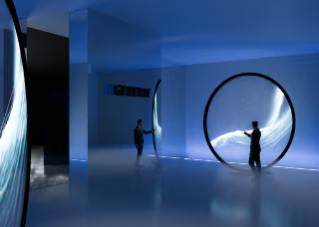
The combination of photovoltaic glass and steel beams generates the sail-shaped roof of Palazzo Italia, already mentioned when focusing on glass at Expo, and featuring a complex 3D design reminiscent of a forest canopy. The structure by Stahlbau Pichler contains 350 tons of steel, divided into a primary frame of trusses with upper and lower chords in circular hollow sections and shaped flat vertical struts, completed by a secondary frame in circular sections and hidden connection joints.
Stahlbau Pichler also executed the metalwork for the UAE Pavilion and its great fibreglass walls, designed by Foster + Partners, are supported by a metal frame, with steel columns and secondary elements, totalling 1,000 tons of material, all bolted together to facilitate dismantling.
The same company built the framework of Michele De Lucchi’s Expo Centre and the German Pavilion.
In the former, the structure supports the building’s wooden cladding in a reference to the Euganean hills, with cones rising to 18.27 and 31.5 metres in height, formed of radial metal trusses resting on steel columns.

The German project sought to use the smallest possible amount of material to limit its environmental impact. Six roofs evoking vegetable forms protect the open spaces with a structure formed of a central circular column anchored to the ground floor and secured horizontally to the slabs of the first and second floors. On high, six horizontal cantilevered beams are fixed transversally to the column and support circular sections to which the semi-transparent membrane is fixed. There are also 12 columns arranged in a circle supporting the five trusses of the main roof structure, for a total of 431 tons of steel.
The Argentine Pavilion adopts steel for both the structure and cladding in a number of cylinders with variable diameters covered with corrugated steel and constructed “dry” using bolts.
For this pavilion, C.M.S. created a number of archways approximately 14 metres wide on which the cylinders rest; the horizontal frames are formed of metal beams and the vertical structures are braced diagonally with tubular steel.

By contrast, Brazil’s Pavilion explores the aesthetic potential of steel, with a long row of openings in Corten steel clad with metal mesh panels. Again, the whole structure was entirely dry-constructed adopting bolted and rational modular systems, without completing the slabs with cast concrete to facilitate dismantling of the pavilion and the clearance of the site.
Speirani Costruzioni developed a special structure for the Azerbaijan Pavilion. Despite having to support considerable loads such as the glass/steel spheres, it has a limited number of pillars and none in the centre of the layout. They built an anti-seismic outer frame designed with a unitary structural system and composed of columns and HEA outer beams, also adopted as the main deck beams (completed by steel profiled sheets and collaborating slabs), plus secondary IPE beams.
The theme of free spans was also key in the Chinese Pavilion and resolved with structural frames with cross and V bracings and a slab formed by a lattice beam system supporting profiled metal sheets. The undulating roof is made of a main steel box girder on which are rested the curvilinear beams in glulam wood, transversally linked by the purlins and stabilised with pre-stressed cross-bracing rods.

As well as the national pavilions, mention must go to the Vanke Pavilion and the roof of the Cardus and Decumanus.
For the former, OCML created a load-bearing structure of curved ribs with variable shapes and main and secondary flat beams, circular hollow sections as bracing elements and hollow profiles for the support of the facade welded on site to steel plates placed at set heights on the external flange of the ribs
The great tensile structure system that accompanies visits to Expo was created with opposed curvature, high resistance, pre-stressed wire cables. The roof membranes are laid between transversely arranged purlins. On each module, the membrane covers half of the span at the level of the load-bearing cables and, for the other half, at the level of the stabilizing cable, so as to facilitate rainwater drainage.

Cantori's timeless elegance becomes outdoor
With elegant lines and solid know-how, Cantori, a leader in furniture design, presents its first line dedicated to outdoor spaces.










